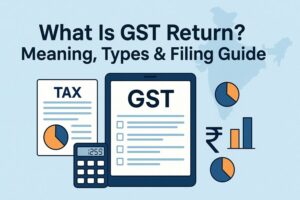Impact of of GST on consumer in India
- 18 Aug 24
- 16 mins

Impact of of GST on consumer in India
Key Takeaways
- GST Simplifies Taxation: GST consolidates multiple taxes into a single tax system, simplifying compliance and reducing administrative burdens for businesses.
- Reduces Cascading Effect: GST eliminates the cascading effect of taxes, thereby reducing the overall tax burden and potentially lowering the prices of goods and services.
- Boosts Transparency: By standardizing tax rates across the country and requiring detailed invoices, GST increases transparency in business transactions and tax liabilities.
- Supports Small Businesses: GST offers specific schemes, like the Composition Scheme, that reduce the tax burden on small business owners, making it easier for them to comply with tax regulations.
- Encourages Compliance: With its input tax credit system, GST incentivizes businesses to maintain accurate records and file returns promptly, promoting a culture of compliance.
The Goods and Services Tax (GST) is a transformative indirect tax reform introduced in India, that consolidates multiple cascading taxes levied by the central and state governments into one comprehensive tax. GST is a value-added tax that is applied at every step of the supply chain, with complete set-off benefits available from the producer's point of view to the retail level. It is imposed on the manufacture, sale, and consumption of goods and services at the national level.
What Exactly is GST?
Introduced on July 1, 2017, by the Indian Government, GST aims to streamline the complex tax structure, making it easier for Indian businesses to comply and for the government to administer. By replacing a myriad of taxes such as excise duty, service tax, customs duty, and state-level value added tax (VAT) and sales taxes, GST has been positioned as a unifying force in the Indian economy, promoting the motto "One Nation, One Market, One Tax."
GST is charged at multiple rates, ranging typically from 0% to 28%, depending on the type of product or service. Essential items necessary for daily use are taxed at lower rates or are exempt altogether, while luxury items and those harmful to the environment attract higher tax rates. This multi-tiered approach aims to ensure fairness and address social and economic inequality.
47th GST Council Update
The 47th GST Council meeting, a pivotal event for the taxation landscape in India, brought several significant updates that affect various sectors of the economy. The council, composed of the Union Finance Minister and the state finance ministers, convenes regularly to review the rates and policies associated with the Goods and Services Tax (GST), ensuring that the tax aligns with the evolving economic conditions and policy objectives.
- Key Decisions
The council made critical decisions aimed at refining the tax structure to reduce the burden on certain sectors while ensuring the tax system remains progressive and comprehensive. One of the notable decisions was the recalibration of GST rates on a range of services and goods, including essential items that directly impact the common man.
- Implications for Business Operating Costs
Businesses across various classes—particularly small and medium enterprises—will experience changes in their operating costs. The council's decision to revise the GST rates on inputs used in production means that the actual cost of goods might decrease, which could lower overall production costs but also impact logistics and transportation costs.
- Adjustments in Tax Rates
The council reviewed the tax rates applicable to specific items, including luxury goods like cars with diesel engines and everyday products such as FMCG goods. The aim was to balance the tax burden across different economic classes, ensuring that the GST system remains fair and does not disproportionately affect the average person.
- Focus on Indirect Taxes and Compliance
The update emphasized the need for better compliance mechanisms, including proper invoicing and the use of advanced GST software and accounting software. This is crucial for enhancing the transparency of the entire process, from production to sales, thereby reducing the scope for tax evasion and increasing government revenues.
Implications of the Council Meeting
The 47th GST Council meeting had profound implications for various aspects of the Indian economy, particularly in adjusting the applicable tax rates across different sectors. These adjustments aim to balance economic growth with inflation control and equitable tax distribution across all classes.

- Adjustments to Tax Rates
The council made pivotal adjustments to the GST rates applicable to various goods and services. These changes are intended to harmonize the tax structure, making it simpler and more predictable, which benefits both businesses and consumers. For example, the council might revise rates on daily household items and FMCG goods to make essential goods more affordable, thereby influencing food costs positively.
- Impact on Inflation
One of the council's critical considerations is managing the inflation rate. Changes in GST rates can either curb or exacerbate inflation. By carefully calibrating the tax rates on services and essential commodities, the council aims to prevent undue inflationary pressure, thus protecting the purchasing power of the average person.
- Service Tax and Business Impact
Adjustments in service tax directly impact business operations, especially in service-oriented sectors such as real estate, beauty services, and professional services. For businesses, these adjustments mean recalculating the cost of services, which can affect overall operating costs and profitability.
- Burden of Taxes Across Economic Classes
The council's decisions directly influence the tax burden across different economic classes. By adjusting tax brackets and considering a fair tax structure, the goal is to ensure that taxes are equitable. Lower economic classes might see a decrease in GST rates on essential goods, while luxury items might carry higher rates to ensure a progressive tax system.
- Implications for Logistics and Transportation Costs
Changes in GST rates on fuel, automobiles, and other logistics-related services directly impact the cost of transport and, subsequently, the cost of goods sold. For businesses that rely heavily on logistics, such as e-commerce and manufacturing, these changes can result in either increased or decreased operating costs.
- Compliance and Procedure
The council also focuses on simplifying the compliance burden for businesses. This involves streamlining the entire procedure for GST filing and payments, potentially through enhancements in GST software and more efficient tax professional services. Furthermore, the introduction or adjustment of schemes like the Composition Scheme aims to make compliance easier for small and medium enterprises.
- Real Estate and Completion Certificates
For the real estate sector, changes in GST rates can influence the costs associated with buying and selling property. The applicable GST rate affects not only the direct cost but also the completion certificates' processing, which are crucial for finalizing real estate transactions.
Latest Update in GST
The 47th GST Council meeting, held under the chairmanship of the Union Finance Minister, addressed several pivotal issues and made substantial updates to the GST framework. These changes aim to refine the implementation of GST, making it more business-friendly and aligned with the current economic scenario. Here’s a summary of the key updates and decisions from the 47th GST Council meeting:
- Rate Adjustments
One of the significant aspects of the council meeting was the revision of GST rates for various goods and services. The adjustments are often aimed at simplifying the structure, reducing the tax burden on essential items, and ensuring fairness across different sectors. This includes reclassifying goods and services for GST purposes to more appropriate tax brackets based on their utility and luxury status.
- Rationalization of Exemptions
The council focused on rationalizing exemptions to minimize complexities and potential misuse. This involves either curtailing exemptions on taxes or specifying conditions under which exemptions can apply, thus broadening the tax base and increasing revenue without significantly impacting consumer prices.
- Clarifications on Taxable Events
Further clarifications on the applicability and scope of GST were provided, aimed at reducing litigation and confusion regarding the taxability of specific transactions. This includes detailed explanations on composite and mixed supplies, cross-border transactions, and transactions involving multiple parties.
- Compliance Measures
To enhance compliance and streamline the process, the council introduced several measures
- Simplified GST return filing procedures for small taxpayers.
- Increased adoption of digital tools and platforms for tax administration.
- Stricter penalties for non-compliance to deter tax evasion and encourage timely filing of returns.
- Measures for Small Taxpayers
The GST Council has historically given special consideration to small and medium enterprises (SMEs), and this meeting was no exception. Measures such as the introduction of special composition schemes for small taxpayers or easing compliance burdens were discussed, which help small businesses by reducing their tax liabilities and simplifying the filing process.
- Sector-Specific Considerations
Particular attention was given to sectors that are sensitive to tax changes, such as the real estate, automotive, and textile industries. The council often provides sector-specific relief or adjustments, which can include tax cuts, rebate increases, or specific compliance relaxations.
- Anti-profiteering
The council also discussed measures to ensure that businesses pass on the benefits of GST rate cuts to consumers. This involves strengthening the legal and operational framework around anti-profiteering measures to protect consumer interests.
- COVID-19 Relief Measures
Given the ongoing impact of the COVID-19 pandemic at the time, the council reviewed and extended certain relief measures related to GST rates on essential goods and services required for COVID-19 treatment and management.
Advantages & Disadvantages of GST
| Advantages of GST | Disadvantages of GST |
|---|---|
| Simplification of Tax Structure | Increased Costs for Small Businesses |
| GST has replaced multiple indirect taxes into a single tax, simplifying the tax regime and making it easier for businesses to comply. | Small businesses face higher compliance costs and the need to upgrade technology systems to adhere to GST regulations. |
| Elimination of Cascading Tax Effects | Initial Implementation Challenges |
| By allowing full tax credit from the procurement of inputs, GST eliminates the cascading effect (tax on tax) and reduces the hidden costs of doing business. | The transition to GST was complex and created initial confusion and administrative difficulties for businesses and the government alike. |
| Higher Threshold for Registration | Complexity for Operating in Multiple States |
| The GST system increases the threshold for tax liability, exempting many small traders and service providers and reducing their tax burden. | Businesses operating across multiple states have to deal with varied compliances and interpretations of GST laws, adding to administrative burdens. |
| Improved Efficiency of Logistics | Technological Dependence |
| GST has reduced the logistics costs and complexities associated with moving goods across state lines, leading to quicker delivery times and lower costs. | The reliance on digital processes for filing and compliance requires robust IT infrastructure, which can be a hurdle for smaller players and those in regions with poor connectivity. |
| Regulation of the Unorganized Sector | Increased Operational Costs |
| Certain industries, like textiles and construction, that were largely unregulated are now under the GST regime, increasing accountability and tax compliance. | Adapting to GST norms involves costs related to system updates, training, and sometimes increased tax burdens, impacting financial operations. |
| Boost to the Economy | Tax Burden on Necessary Services |
| By streamlining the tax structure, GST can potentially lead to an increase in economic activity and attract foreign investments. | Some essential services have seen an increase in tax rates under GST, which can burden the lower economic strata of society. |
GST and its Positive Impact on Consumers
The implementation of the Goods and Services Tax (GST) has brought several benefits for consumers, contributing to more transparent pricing, reducing the tax burden on goods and services, and fostering a more competitive market environment. Here's an overview of how GST positively impacts consumers:
- Simplified Tax Structure
GST has replaced a plethora of indirect taxes, such as VAT, service tax, excise duty, and others. This simplification helps consumers understand exactly how much tax they are paying, which was more opaque in the previous tax regime. The clarity on taxes enhances consumer trust and ensures that the tax rates applicable are consistent and predictable across different states.
- Reduction in Overall Tax Burden
One of the most significant advantages of GST for consumers is the elimination of the cascading effect of taxes, or 'tax on tax,' which was prevalent under the old tax system. By implementing a uniform tax rate, GST has generally reduced the tax burden on consumers buying goods and services, making daily household items and essential services more affordable.
- Cheaper Costs of Goods and Services
GST has led to a decrease in the cost of services and goods in several sectors by allowing businesses to claim input tax credit. This means that the entry taxes paid on inputs can be deducted from the taxes on outputs, reducing the end cost for consumers. Categories of products such as FMCG goods, automobiles, and consumer durables have seen a reduction in prices, benefiting the common people.
- Enhanced Consumer Protection
Anti-profiteering provisions in the GST are there to make sure that any tax rate reductions benefit consumers rather than businesses. This measure is crucial in maintaining fair pricing and protecting consumer interests, especially in sectors like real estate and retail.
- Improved Service Delivery
The impact of GST extends into service sectors such as banking, insurance, and telecommunications, where simplified tax procedures and reduced costs have enabled service providers to enhance the efficiency and quality of customer service. For instance, reduced GST on banking and insurance services makes these services more accessible to all economic classes.
- Increased Market Competition
By levelling the playing field between large enterprises and small and medium businesses, GST fosters a competitive market environment. This competition often leads to better product quality, more innovation, and lower prices, all of which benefit consumers directly.
- Transparency in E-Commerce
GST has standardized tax rates across the country, which is particularly beneficial in the e-commerce sector, where businesses sell goods across state lines. This uniformity ensures that no additional taxes or hidden charges are imposed based on location, making online shopping more straightforward and transparent.
GST and its Negative Impact on Consumers
While the implementation of the Goods and Services Tax (GST) in India was designed to streamline current taxation, promote transparency, and enhance compliance, it has also introduced several challenges for consumers. Here’s an overview of the negative impacts of GST on consumers:

- Increased Costs for Some Services
GST has introduced higher tax rates for certain services, significantly impacting the cost for consumers. For instance, services such as banking and insurance have experienced a rise in tax rates under GST, which directly inflates the costs of these services for consumers.
- Complexity in Tax Rates
Although GST was intended to simplify the tax structure, the reality has been different for consumers. The presence of multiple tax rates for various goods and services can lead to confusion. Consumers often struggle to understand the applicable taxes on different products, such as daily household items, cosmetics, and FMCG goods, making it challenging to estimate the real cost of purchases.
- Inflationary Pressure
The rollout of GST brought about an initial surge in inflation, particularly noticeable in service prices. This increase has had a substantial impact on the costs of food and daily household items, adding a significant financial burden on average consumers.
- Burden on Small Businesses Transferred to Consumers
Small businesses, particularly those that are newly subject to the comprehensive compliance requirements of GST, face increased operational costs. These businesses often pass on these additional expenses to consumers, resulting in higher prices for goods and services.
- Delayed Input Tax Credit Benefits
The input tax credit is a fundamental feature of the GST system, intended to prevent the cascading effect of taxes. However, delays in processing these credits can lead to temporary price hikes, which businesses might pass on to consumers until the credits are reconciled.
- Increased Compliance Costs
Adapting to GST-compliant software and systems involves significant costs. These expenses have led to increased operational costs for businesses, which are often passed on to consumers in the form of higher service charges.
- Anti-profiteering Issues
There have been notable instances where businesses have failed to pass on the benefits of reduced tax rates to consumers. This lack of compliance with anti-profiteering rules has negatively impacted consumer trust and contributed to a lack of transparency in pricing.
Conclusion
While GST has its pros and cons, its implementation has broadly aimed at economic reform and simplification of the tax structure. The ongoing updates and refinements by the GST council show a commitment to addressing the concerns of all stakeholders.
💡Missing the deadlines to GST payments on time? You can download and use Pice Business Payment App to pay all your business expenses, like GST, vendors, utilities, and many more, with your credit card at the cheapest price.
 By
By 

















